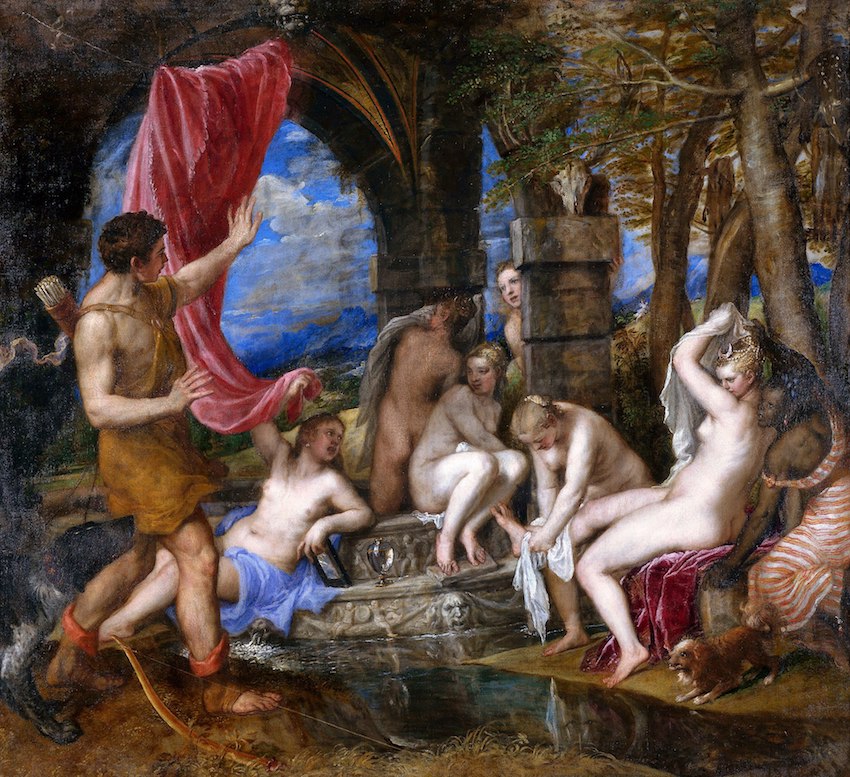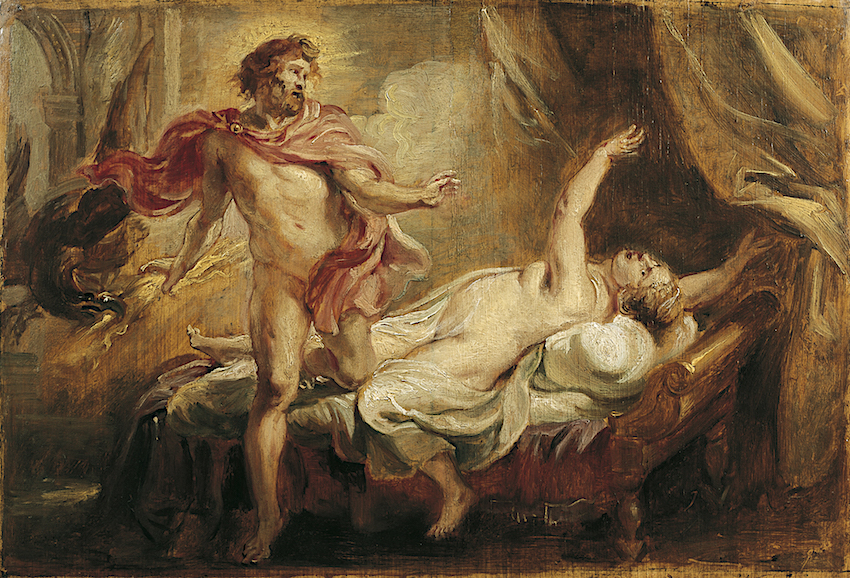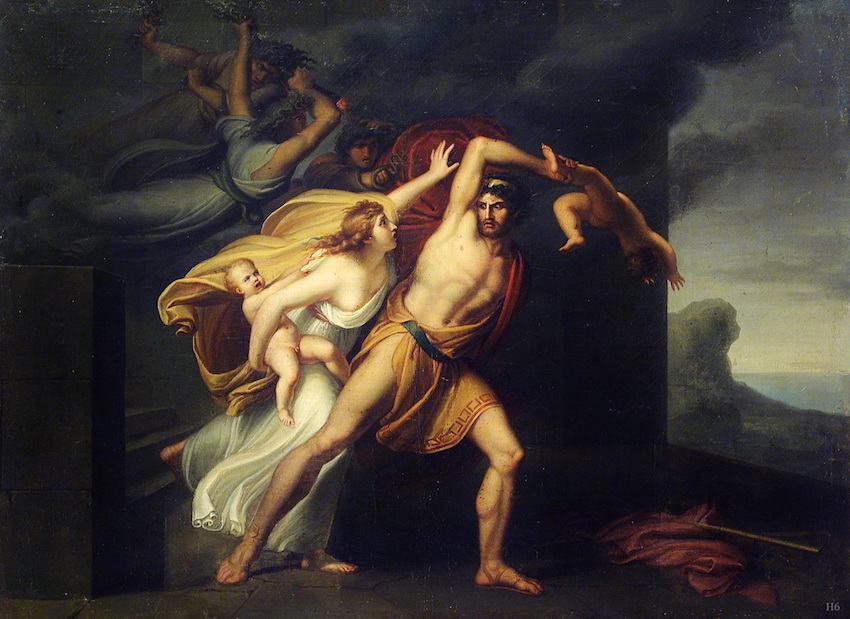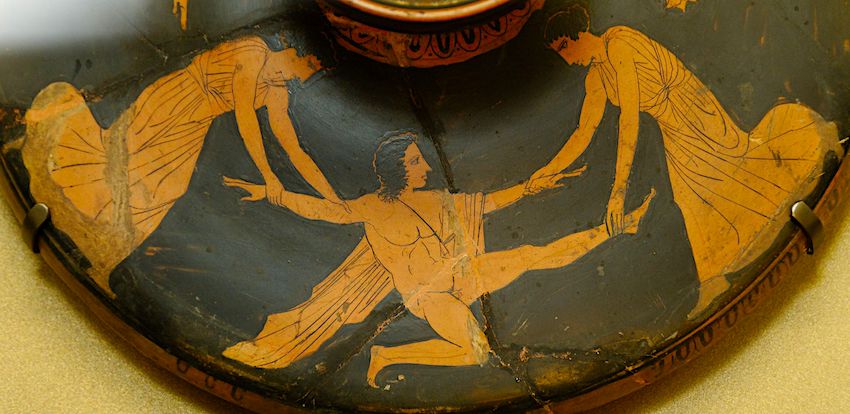The Myths of Thebes
Kadmos' Daughters
The myths of Kadmos' daughters revolve around the god Dionysos, whose birth, upbringing, and triumphant return dominate this phase of Theban mythical history. After looking at the lives of the four daughters individually, we will return to them in the context of Dionysos' career.
Autonoe

Titian - Diana and Actaeon - 1556-1559. National Gallery of London
Kadmos' daughter Autonoe married Aristaios, the famous hunter and farmer,
and their children were a son Aktaion and a daughter Makris. Aktaion grew up to
become a great hunter, but died when he offended the goddess Artemis. While
hunting with his pack of fifty dogs on Mount Kithairon, he accidentally came
upon Artemis bathing with her attendant nymphs in a stream. Since it was
forbidden to see Artemis naked, the goddess changed him into a deer and his dogs
tore him to pieces.
Others said that Aktaion was punished for boasting that he was a better hunter than Artemis, or for trying to rape her, or for trying to marry his aunt Semele, with whom Zeus was in love.
Aktaion's father Aristaios was the son of Apollo and Kyrene. Kyrene, daughter of the Lapith king Hypseus, as a young girl refused to participate in women's activities and spent her time hunting. One day Apollo saw her wrestling a lion unarmed and asked Cheiron about her. The wise centaur predicted that Apollo would carry her off to Libya, where she would become the mother of Aristaios, and that Hermes would take her baby to Gaia and the Horai, who would nurse the infant with nectar and ambrosia. In other versions, Apollo gave the boy to Cheiron to raise, or gave him to certain nymphs who taught him to make cheese and raise bees and olive trees.
When Kyrene arrived in Libya, king Eurypylos offered his kingdom to the person who would kill a marauding lion; Kyrene did the task and won the kingdom. Her children by Apollo were Autouchos (who stayed in Libya), Idmon (an Argonaut prophet), and Aristaios; by the god Ares she had a son Diomedes, whose man-eating mares are the objective of Herakles' eighth labor.
When Aristaios grew up, the Muses married him to Autonoe and taught him the arts of healing and prophecy. The children of Aristaios and Autonoe were Aktaion and Makris, who will become a famous nurse of Dionysos. At some later time, all of Aristaios' bees died and he asked his mother Kyrene for advice. She told him to catch the sea-god Proteus; he did so, and learned from Proteus that his amorous pursuit of Orpheus' wife Eurydike had caused her death, since she had stepped on a poisonous snake while fleeing and had died from its bite. Kyrene told Aristaios to sacrifice bulls and heifers to appease Eurydike's companions and to return nine days later. When he came back, he found that a new swarm of bees had been born from the rotting carcasses of the sacrificed animals.
After the death of Aktaion, Aristaios spent his time travelling: he ended a plague in Keos, returned to Libya, lived for a while in Sardinia and Sicily, and finally visited Dionysos in Thrace, where he was initiated into the Dionysian Mysteries and then disappeared forever from mortal sight.
Semele

Death of Semele by Peter Paul Rubens
Another daughter, Semele, caught the attention of Zeus and became pregnant by him. He promised Semele he would do whatever she asked of him, and he tried to keep their affair hidden from Hera. As always, Hera knew what Zeus was up to, and one day she diguised herself as Semele's nurse or a woman of Thebes and came to see Semele, who was six months pregnant. Who is the father?" she asked, and Semele replied that Zeus was her lover. "How do you know?" said Hera, "If you want to know for sure, ask him to make love to you as he does with his wife Hera."
That night Zeus came to visit Semele, and she asked him for a favor. "Anything you want," he said, and she replied, "Make love to me as you would with Hera." "I wish you hadn't asked that," said Zeus, and left the room. Semele was sitting on the bed, wondering what had happened to her lover, when suddenly the doors crashed open, Zeus drove in with his chariot and horses, and threw a lightning bolt at Semele. She was reduced to a pile of ashes, but the foetus was unharmed; Zeus made an opening in his "thigh," put the foetus inside, and sewed up the opening. Four months later he opened his thigh and Dionysos was born. Zeus had Hermes take the infant to Semele's sister Ino, who agreed to take care of him, but Hera drove Ino (and sometimes her husband Athamas) mad. Again Hermes had to save Dionysos; disguising him as a baby goat, he took him east to the nymphs of Nysa,
After the death of Semele, her sisters claimed that she never had Zeus for a lover and that Zeus had killed her with lightning because he was angry at her for telling this lie. In some versions this is why Dionysos drove the sisters mad when he grew up and returned to Thebes.
Many years later Dionysos went to the underworld to bring back his mother. Semele was taken to Olympos to live with the gods, and was known from then on as the goddess Thyone.
Ino

Atamante preso dalle Furie by Arcangelo Migliarini (1801) at Roma, Accademia di San Luca
A third daughter, Ino, became the second wife of Athamas, son of Aiolos and king of the Boiotian city Orchomenos. Athamas had earlier been married to Nephele (whose name means "Cloud") and had two children, Phrixos and Helle, by her, but Nephele had disappeared one day and Athamas got married again, to Ino. Athamas and Ino had two children, Learchos and Melikertes, and Ino was so intensely jealous of her stepson Phrixos (presumably because she feared that he would inherit the kingdom of Athamas) that she devised a bizarre scheme to get rid of him. First, she somehow persuaded the local women to roast the seed grain, so that when it was planted nothing would grow. Then, when Athamas sent an embassy to Delphi to ask the oracle how to avoid a famine, she bribed the messengers to tell Athamas that the oracle commanded him to sacrifice his son Phrixos.
Athamas led his son to the altar (or Phrixos himself volunteered to die), but at the last moment Nephele (the cloud) appeared and gave her children a flying ram with a golden fleece. They climbed aboard and flew off to the northeast. While they were flying over the Hellespont, Helle fell into the sea which bears her name (Hellespont = Sea of Helle). Phrixos continued flying on the ram until he reached Kolchis, at the far end of the Black Sea. Here the ram itself told Phrixos to sacrifice it and hang the fleece on a tree in the sacred grove of Ares.
Now Ino was alone with Athamas and their two children, but Hermes appeared and gave to her the infant Dionysos, son of Zeus and Ino's late sister Semele. Ino nursed the baby and agreed to raise it as a girl, in the hope of deceiving Hera, who hated Dionysos and Herakles most of all of her husband's illegitimate sons. However Hera knew what Ino was up to, and she drove her mad. Hermes took Dionysos, disguised as a baby goat, to the nymphs of Nyssa in Asia to raise, and the mad Ino disappeared into the wilderness.
When Ino had been gone for some time, Athamas married again; his third wife was Themisto, and she bore several sons to Athamas. But now Ino recovered from her madness and appeared at the palace of Athamas. He said to her, "You're welcome to come back and stay in the palace, but I've remarried. You can have a position as nanny to your children and those of my wife Themisto," and Ino agreed. One day Themisto, who was as jealous of her stepchildren as Ino was of hers, told the nanny (not knowing the nanny was Ino) to put black blankets on Ino's children and white blankets on her own two children who slept in the same room. Ino realized that Themisto intended to kill her children, and she put the black blankets on Themisto's children. That night Themisto came into the bedroom and killed her own children, then killed herself.
At this point Hera again intervened and drove both Athamas and Ino mad; Athamas killed their son Learchos, thinking he was some kind of wild animal, and Ino jumped into the sea holding her son Melikertes. Athamas' brother Sisyphos found Melikertes' body and changed (or instituted) the Isthmian Games so that they would be in honor of Melikertes. Aphrodite, Ino's grandmother, persuaded Poseidon to help, and he changed Ino and Melikertes into the sea-deities Leukothea and Palaimon.
In her role as the goddess Leukothea, Ino helps Odysseus when he is lost at sea. As in her nurturance of Dionysos, she plays a maternal role with Odysseus, giving him an umbilicus-like veil which he must tie "under his chest" and give back to the sea when he finally reaches land.
Agave

Pentheus torn apart by Agave and Ino. Attic red-figure lekanis (cosmetics bowl) lid, ca. 450-425 BC.
The fourth daughter of Ino is Agave, whose son Pentheus became king of Thebes after Kadmos abdicated the throne. During the reign of Pentheus, Dionysos returned to Thebes and drove all the women mad. They abandoned their homes and families and spent all their time in ecstatic revelry on Mount Kithairon with the followers of Dionysos, the Mainads (the name means "the mad ones"). Pentheus opposed the new god and his religion, and imprisoned the man he thought was their leader (who was actually Dionysos himself). But an earthquake tore down the prison and Dionysos hypnotized Pentheus, easily persuading him to dress as a woman and spy on the activities of the Mainads. Dionysos placed Pentheus in the top branches of a pine tree, where the women spotted him, caught him, and tore him to pieces, thinking he was a mountain lion. Agave herself returned to Thebes with her son's head impaled on a stick. When she came to her senses she was exiled, along with her parents, and the three of them went to Illyria (modern Albania). Here Agave married the king, then killed him so that Kadmos could be king.
Polydoros and Labdakos
Kadmos' son Polydoros became king after the death of Pentheus, and was
succeeded by his son Labdakos. Both Polydoros and Labdakos are shadowy figures
virtually unmentioned in mythology, with two exceptions: Pausanias says that
both died when their sons (and heirs) were too young to succeed them, and
Apollodoros says, mysteriously, that Labdakos thought and died like
Pentheus.
